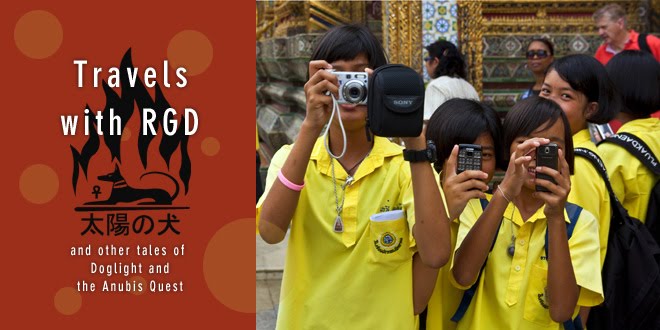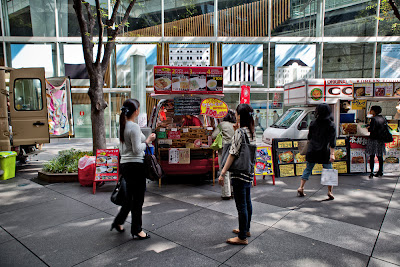All marterials including photographs are ©2011 Ronald Gary Dunlap / Doglight Studios.
All rights reserved
This morning, I skipped breakfast and went straight to the train station. Following the directions in Rough Guides Tokyo, I took the Yamanote Line to Sugamo Station. I exited and began a 15-minute walk to the northwest, where I was to find the Toden-Arakawa Line, the last remaining tram in Tokyo.
In the early 1900s, there were several privately run "ding ding trains" that were commercially viable throughout Tokyo, but they have slowly disappeared over the years, until today only this 7.5-mile line lives on.
After exiting Sugamo Station, I started walking northwest without any real idea of where I was heading. I trusted that the guidebook knew what it was talking about.
With no McDonald's in sight, I stopped at a small snack shop and bought a fruit cup along with a bottle of water to stem my growing hunger. The fruit cup cost ¥630, and the bottle of water was ¥150, which totaled a little over 10 bucks, almost twice as much as a breakfast at Denny's. Damn my foolishness!
I walked farther on for about ten minutes when I spotted a sign pointing north to Somei Cemetery, and since I have a long-standing interest in the symbology of death, I thought a side trip was in order.
Somei Cemetery extends over a hilly rise nestled in a maze of residential housing. This serene enclave is the resting place for some of Japan's most notable citizens of the past couple of centuries. Named for the species of cherry tree that grows in this precinct, the cemetery is best viewed in April, when the trees are in bloom. Since it was September, I just wandered through the elaborate stone reminders of the fleeting nature — even for the rich and famous — of life.
I was nearing the far side of the cemetery when I came across a designated rest area for weary visitors and those in need of reflection. The area is bordered by cypress trees and a warning sign reconfirming my impression that the sinister, large-billed crow (Corvus macrorhynchos) has a wide sphere of influence in the Tokyo metropolitan area. (Every morning I peered out from my eleventh-floor window at the boisterous black crows in conclave.)
From the cemetery, I walked back to my starting point and crossed the street to a temple of tattered lanterns and some fine old stone statues of Buddhist saints. At the temple's main sanctuary, I made the obligatory donation, selected several sticks of incense, and burned a little to ask the gods for good luck.
Heading northwest again, I found myself wandering along a stretch of road that was crowded with elderly female shoppers. I later learned that this was Jizo-dori Street (nicknamed "Old Ladies Harajuku"). It specializes in cutting-edge fashions for ladies above a certain age, and the merchants here were doing a brisk business.
A little farther on was the Togenuki Jizo Temple, overflowing with visitors and parishioners. I'm guessing there was some kind of special event going on. A few itinerant monks in their large, bowl-shaped hats (called "gasa") were performing traditional healing techniques in an effort to alleviate the maladies afflicting the temple's parishioners. I wanted to snap a couple of shots without being overly offensive, but the right moment never materialized.
Near the temple I saw a tile mural with a picture of a tram. I pantomimed a question to a lady selling drinks near the mural and pointed at the tram, and she pointed farther up the road.
A good 40 minutes after I started my walk, I found the tram line. I don't know what I was expecting, but this was a little too modern and efficient for me. I watched several groups of passengers board and the train move away.
I finally paid the ¥160 and boarded a southbound tram to experience this rejuvenated symbol of the past. After a 20-minute ride, the tram pulled in to a tram station just a few steps from the northern entrance of Otsuka Station. I don't know what the writers of Rough Guides Tokyo were thinking, but it is far more practical to take the JR Line to Otsuka Station than board the tram for its northbound and return run.
From Otsuka Station I took the Yamanote Line south a couple of stops to Tokyo Station. After arriving at this major hub, I traipsed around for a while looking for the Tokyo International Forum. Somehow I got turned around, so I finally had to stop and ask a policeman for directions.
The building, designed by American architect Rafael Viñoly, is a major landmark in Tokyo. The travel guides describe the interior as like being inside the framework of a boat, but to me, it's more like being inside some giant Japanese movie monster (e.g., Godzilla or Mothra) and staring out through the beast's ribs. The outer skin is made up of over 2,000 earthquake-resistant glass panels that shimmer in the afternoon light. Even if the building is quake-resistant, I'm not sure I would like to be here during a major seismic event.
In the courtyard of the forum is a very informal and inviting area to have lunch. Something comparable to the food trucks in the United States, it offers a wide variety of tasty items at reasonable prices.
I walk the streets in my serpentine patter and come across an Italian restaurant, where I head inside for some spaghetti Bolognese.
After my late lunch, I walked over to the Ginza, looking for the Apple store and the Sony building. I located the Sony building first and climbed up the five or six floors, each designated for a different technology. Unfortunately, I didn't find anything impressive; it was sort of like a multi-level Best Buy. I mean, no one builds a better TV, but where's the next thing? Where's the Discman/Trinitron innovation? Where's that new "I can't live without it" product?
Disappointed, I again stopped at a police substation and asked for directions. The Apple store, encased in a polished metal exoskeleton, was a few blocks southwest of the cop shop. The store occupies the bottom two floors of a multi-storied commercial building, with pretty much the same layout and products you'd see at any store in the States. I spoke with a few of the Apple salespeople, but they couldn't point to anything unique, so I took a couple of shots and left to head back to Shinjuku, wondering what I had really expected. During my research for this trip, I kept reading about how high-tech everything was here, but there was nothing I hadn't seen before.
I was back in Shinjuku about 6. I put the camera away and headed down to the lobby to relax a little and put things into perspective.











































